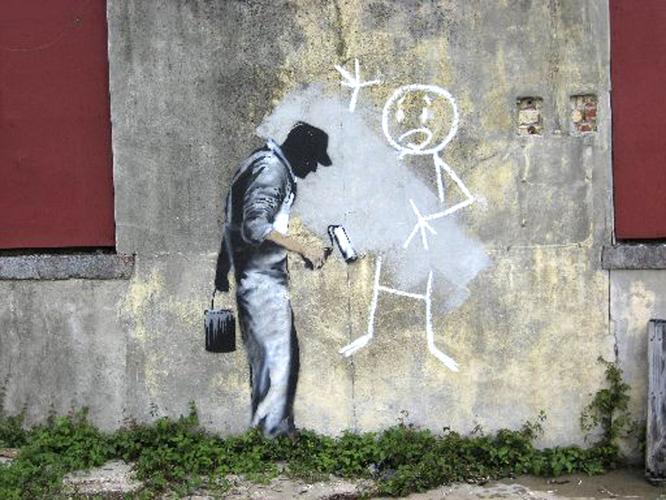Earlier this week I took a nostalgic tour of New Orleans in search of the remaining works by renowned British graffiti artist Banksy, who visited almost exactly five years ago. I found that three of the original 14 stencil paintings can still be seen. A few others are boarded up or painted over. In four cases, the buildings where the paintings appeared have been demolished.
There’s a part of me that wished more Banksys were preserved. On the other hand, I doubt that the celebrated street artist intended New Orleans to be a museum; he intended it to be a social and political laboratory.
It certainly is.
Another reason for Banksy’s popularity is, well, populism. Banksy’s street art is free and clear. There’s no museum exhibition admission, no gallery markup, no public art management fee, no profit. Behind the scenes, I suspect Banksy has done pretty well for himself in stencil sales – the New Orleans Museum of Art has a copy of the umbrella girl stenciled on canvas – but in public art terms he’s Robin Hood.
And the realistic nature of Banksy’s designs eliminates any residual modern art snobbishness.
GONE, NOT FORGOTTEN
If you wander 2013 New Orleans searching for Banksys, you'll find a landscape in flux. The flooded green building on St. Claude Avenue where the patriot was painted is gone. So is the abandoned cement block barroom on Claiborne where the kid with the life preserver was painted. There are parts of town where Katrina and the flood are becoming distant memories. In much of the Lower Ninth Ward, it can seem like the disaster happened just days ago.
While searching for the location of a lost Banksy, I noticed a house still marked with the spray-painted National Guard code that indicated a dead body was found in October 2005 (1 DOA, 10/15). That remains the most chilling sort of post-K graffiti.
Here's a starry pop-culture collision that took place right down on Claiborne Avenue in the Lower 9th Ward. In 2008, Banksy painted his kid swinging on a life preserver very near the future site of Brad Pitt's modern architectural development, Make It Right. Coincidentally, Pitt reportedly spent $2 million on a Banksy painting at auction.
The blue corner townhouse on Oretha Castle Haley, where the gas mask band once marched is gone, replaced by a modern office building. The dilapidated and partially burned building near the corner of Canal Street and Sourth Derbigny, where Banksy painted his homeless Abraham Lincoln is also gone. In fact, almost everything is gone for a block in every direction, to make room for the forthcoming hospital complex.
This June, a Banksy stencil was cut from a London wall and sold at auction for $1.1 million. Too bad the New Orleans property owners couldn't have cashed in.
I’ve heard that the ruined 7th Ward residence where Banksy painted his wind-blown horn player also is gone. But I can’t be sure because I never knew exactly where it was in the first place – somewhere near Poland and Claiborne Avenues, I was told. I also never laid eyes on the kid with an escaped umbrella painted on the Industrial Canal floodwall.
Banksy's portrait of Bart Simpson on the abandoned hardware store at St. Bernard Avenue and North Robertson Street survived for years. Now it's boarded over. Renovation of the landmark Circle Grocery Store across the street seems to be in full swing.
In three former Banksy locations I visited, men were mowing very tall grass. The smell of searching for Banksys on their fifth anniversary is the smell of chopped sub-tropical growth. In one location, a goat baaaaed excitedly as I took photos. It’s as if New Orleans has become closer to the earth over the past five years – or maybe it’s just my imagination.
There’s a slight possibility, of course, that Banksy didn’t visit New Orleans in 2008 or anytime. After all, an outlaw guerilla artist must preserve his anonymity and can’t really take responsibility for his art. Since 2008, a handful of Banksy-like stencils have appeared on Crescent City masonry, giving rise to flurries of excitement. But knowledgeable Banksy watchers seem to agree that the 2008 visit was for real; the rest were imitations.
Here’s a final irony: Banksy’s sinister anti-graffiti activist on the corner of Clio and Carondelet streets is still in perfect shape, although the strip of fuchsia paint that surrounds it visually smothers Banksy’s subtle design. And Banksy’s anti-graffiti crusader on the antique Jackson Avenue fire station near the river is in pretty good shape, though faded. That means two of the three Banksys that have survived the longest depict the anti-graffiti zealots that were supposed to be the bane of Banksy and by extension all street artists.
There may be some metaphor in that.






















